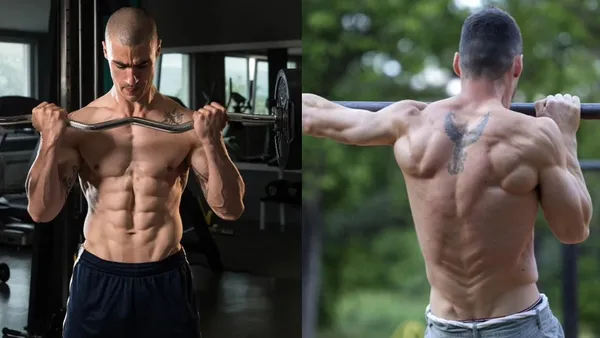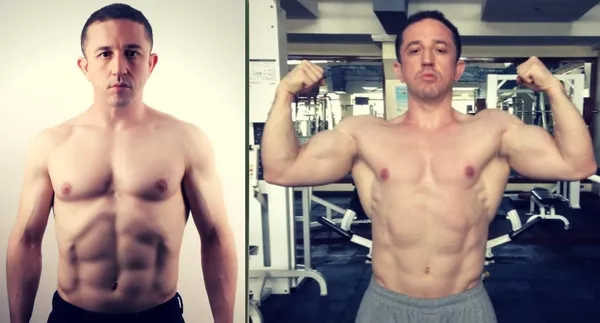Table of Contents
Welcome to Kizworld, your go-to source for all things fitness. In this article, we're going to be talking about weights vs calisthenics. We'll discuss the pros and cons of each, and help you decide which one is right for you. Whether you're a beginner or a seasoned pro, we've got you covered. So sit back, relax, and let's get started.
Weights vs Calisthenics: The Ultimate Guide to Choosing the Best Workout for You
Weights | Calisthenics | |
|---|---|---|
Muscle mass | Increased | Improved |
Strength | Improved | Improved |
Bone density | Increased | Improved |
Risk of injury | Reduced | Reduced |
Cardiovascular health | Improved | Improved |
Body composition | Improved | Improved |
Flexibility | Improved | Improved |
Coordination | Improved | Improved |
Balance | Improved | Improved |
I. Weights vs Calisthenics: Building Strength and Fitness
Benefits of Weights
Weight training offers numerous benefits for building strength and fitness. It helps increase muscle mass, leading to improved strength and power. Additionally, weights can enhance bone density, reducing the risk of osteoporosis and fractures. Regular weight training can also improve cardiovascular health by strengthening the heart and blood vessels.
When it comes to body composition, weight training can help reduce body fat and improve lean muscle mass. This can result in a more toned and defined physique. Furthermore, weights can improve flexibility, coordination, and balance, contributing to overall physical fitness.
Benefits of Calisthenics
Calisthenics, on the other hand, is a form of bodyweight training that utilizes body movements to build strength and fitness. It offers similar benefits to weight training, including increased muscle mass, improved strength, and enhanced bone density.
Calisthenics can also improve cardiovascular health, body composition, flexibility, coordination, and balance. Additionally, it can be a more accessible and cost-effective way to get fit compared to weight training, as it requires no special equipment or gym membership.
Weights | Calisthenics | |
|---|---|---|
Muscle mass | Increased | Improved |
Strength | Improved | Improved |
Bone density | Increased | Improved |
Risk of injury | Reduced | Reduced |
Cardiovascular health | Improved | Improved |
Body composition | Improved | Improved |
Flexibility | Improved | Improved |
Coordination | Improved | Improved |
Balance | Improved | Improved |
Ultimately, the best choice for building strength and fitness depends on individual goals, preferences, and circumstances. Both weights and calisthenics offer effective ways to achieve these goals, and combining them can provide a well-rounded approach to fitness.
- How to Do a Muscle-Up
- The Best Calisthenics Gifts and Accessories
- The Best Calisthenics Quotes and Motivation
Weights vs Calisthenics: Building Strength and Fitness
II. Benefits of Weights and Calisthenics
Improved Muscle Mass and Strength
Weights and calisthenics are both effective ways to build muscle mass and strength. Weights provide resistance through the use of external weights, while calisthenics uses bodyweight as resistance. Both methods can lead to increased muscle size and strength, but the specific results will vary depending on the individual's training program and genetics.How to Build Muscle and Strength with Calisthenics
Improved Bone Density
Weights and calisthenics can also help to improve bone density. Bone density is important for preventing osteoporosis, a condition that can lead to weak and brittle bones. Weight-bearing exercises, such as weights and calisthenics, can help to increase bone density by putting stress on the bones. This stress stimulates the bones to become stronger and denser.How to Improve Your Posture
Reduced Risk of Injury
Weights and calisthenics can also help to reduce the risk of injury. By strengthening the muscles and bones, weights and calisthenics can help to improve balance and coordination. This can help to prevent falls and other injuries.
Type of Exercise | Benefits |
|---|---|
Weights | Increased muscle mass and strength, improved bone density, reduced risk of injury |
Calisthenics | Improved muscle mass and strength, improved bone density, reduced risk of injury |
Improved Cardiovascular Health
Weights and calisthenics can also help to improve cardiovascular health. Cardiovascular health is important for reducing the risk of heart disease, stroke, and other health problems. Weight-bearing exercises, such as weights and calisthenics, can help to improve cardiovascular health by increasing the heart rate and blood flow.How to Design Your Own Calisthenics Routine and Program
Improved Body Composition
Weights and calisthenics can also help to improve body composition. Body composition refers to the ratio of muscle to fat in the body. Weights and calisthenics can help to improve body composition by increasing muscle mass and reducing body fat.The Best Calisthenics Exercises and Variations
Improved Flexibility and Coordination
Weights and calisthenics can also help to improve flexibility and coordination. Flexibility is important for preventing injuries and improving range of motion. Coordination is important for performing everyday activities and sports. Weights and calisthenics can help to improve flexibility and coordination by stretching the muscles and improving balance.How to Learn the Basic Calisthenics Skills and Progressions
Improved Balance
Weights and calisthenics can also help to improve balance. Balance is important for preventing falls and other injuries. Weights and calisthenics can help to improve balance by strengthening the muscles and improving coordination.How to Do a Handstand
Benefits of Weights and Calisthenics
III. Choosing the Right Option for Your Goals
When choosing between weights and calisthenics, the best option for you depends on your individual goals. If your goal is to build muscle mass, weights may be a better choice. Weights provide resistance that can help you to build muscle faster than calisthenics alone. However, if you are interested in a more functional type of training that can improve your overall strength and fitness, calisthenics may be a better choice for you. Calisthenics exercises use your body weight as resistance, which can help to improve your strength, endurance, flexibility, and coordination.Ultimately, the best way to decide which option is right for you is to try both and see what you enjoy more. If you are new to weightlifting, it is important to start with a light weight and gradually increase the weight as you get stronger. Similarly, if you are new to calisthenics, start with simple exercises and gradually progress to more challenging ones as you get stronger and more coordinated.No matter which option you choose, be consistent with your workouts and you will see results. Here is a table that compares the benefits of weights and calisthenics:
Benefit | Weights | Calisthenics |
|---|---|---|
Muscle mass | Increased | Improved |
Strength | Improved | Improved |
Bone density | Increased | Improved |
Risk of injury | Reduced | Reduced |
Cardiovascular health | Improved | Improved |
Body composition | Improved | Improved |
Flexibility | Improved | Improved |
Coordination | Improved | Improved |
Balance | Improved | Improved |
As you can see, both weights and calisthenics have their own unique benefits. The best option for you depends on your individual goals and preferences. If you are still unsure which option is right for you, consult with a fitness professional.
Here are some additional things to consider when choosing between weights and calisthenics:
- Time commitment: Weights workouts tend to be shorter than calisthenics workouts. This is because weights workouts are more focused on strength training, while calisthenics workouts often incorporate cardio and flexibility exercises as well.
- Cost: Weights workouts require a gym membership or home gym equipment. Calisthenics workouts can be done anywhere, so they are more cost-effective.
- Convenience: Weights workouts require you to go to a gym or have a home gym. Calisthenics workouts can be done anywhere, so they are more convenient.
Ultimately, the best way to decide which option is right for you is to try both and see what you enjoy more. Be consistent with your workouts and you will see results.
Here are some inspirational quotes to help you on your fitness journey.
Choosing the Right Option for Your Goals
IV. Combining Weights and Calisthenics for Optimal Results
Benefits of Combining Weights and Calisthenics
Combining weights and calisthenics can provide a comprehensive approach to fitness, offering a wide range of benefits. By incorporating both forms of exercise into your routine, you can maximize muscle growth, strength, and overall fitness.
- Increased muscle mass: Combining weights and calisthenics can help you build muscle mass more effectively than either method alone. Weights provide resistance that challenges your muscles, leading to hypertrophy (muscle growth). Calisthenics, on the other hand, helps you develop functional strength and muscle endurance, which can support your weightlifting efforts.
- Improved strength: Both weights and calisthenics can improve your strength. Weights allow you to lift heavy loads, which can increase your maximal strength. Calisthenics, on the other hand, helps you develop functional strength, which is the ability to use your strength in everyday activities.
- Enhanced cardiovascular health: Calisthenics exercises often involve dynamic movements that can elevate your heart rate and improve your cardiovascular health. Combining calisthenics with weightlifting can provide a well-rounded workout that benefits both your muscular and cardiovascular systems.
How to Combine Weights and Calisthenics
To effectively combine weights and calisthenics, consider the following tips:
- Start gradually: If you're new to weightlifting or calisthenics, start slowly and gradually increase the intensity and frequency of your workouts over time. This will help you avoid injuries and allow your body to adapt to the new demands.
- Choose exercises that complement each other: When combining weights and calisthenics, choose exercises that target different muscle groups or movement patterns. For example, you could do a weightlifting exercise for your chest, followed by a calisthenics exercise for your back.
- Listen to your body: It's important to listen to your body and rest when needed. If you're feeling tired or sore, take a break or reduce the intensity of your workout. Pushing yourself too hard can lead to injuries.
Sample Workout Plan
Here's a sample workout plan that combines weights and calisthenics:
Day | Workout |
|---|---|
Monday | Weights: Chest and triceps Calisthenics: Back and biceps |
Tuesday | Weights: Legs and shoulders Calisthenics: Core and flexibility |
Wednesday | Rest |
Thursday | Weights: Back and biceps Calisthenics: Chest and triceps |
Friday | Weights: Legs and shoulders Calisthenics: Core and flexibility |
Saturday | Rest |
Sunday | Active recovery (e.g., walking, swimming, yoga) |
Remember, this is just a sample plan. You can adjust it to fit your fitness level and goals. It's also important to consult with a qualified personal trainer if you have any concerns or need guidance.
Combining Weights and Calisthenics for Optimal Results
V. Conclusion
**Weights vs Calisthenics: Which Is Right for You?** Ultimately, the best way to decide which type of training is right for you is to try both and see what you enjoy more. But if you’re looking for a more structured and challenging workout, weights may be a better choice. If you’re looking for a more convenient and bodyweight-based workout, calisthenics may be a better choice. No matter what you choose, the most important thing is to find an activity that you enjoy and that you can stick with. So get out there and start moving! 💪